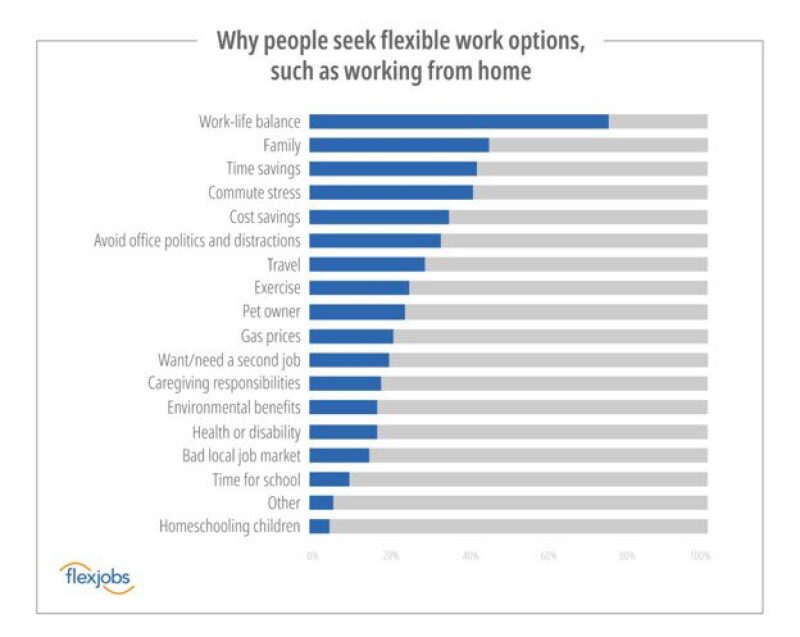It comes as no surprise that working from home has been on the rise this century, with 5.2% of Americans working from home full time as of 2017 according to CNBC. In addition, 43% of workers reported working from home occasionally in 2016 (up from 39% in 2012) as reported by a business journal. This falls far short of the 82% of workers who indicated in a LinkedIn survey that they would like to work from home at least once a week in 2019 . And a Forbes article suggests there are a significant number of workers that would like to work from home occasionally, but haven’t previously had the opportunity. However, in the last few months, many of them have received a taste of what the work-from-home life is about as evidenced by the boom in usage of Microsoft Teams and Zoom, two applications that offer teleconferencing services.
Working From Home: The New-Normal for Office Staff?
It goes by many names—remote work, telework, and work from home being some of the most common. Once the purview of Silicon Valley and the tech world, it has suddenly become the new way of working for millions of office workers across the globe as governments issued stay-at-home orders and isolation measures to fight the spread of COVID-19.
Oil and gas operations have often been labeled “critical businesses” (or similar designation, depending on the authority in question), allowing them to continue operating, but even so, employers are encouraging employees that can work from home to do so in order to reduce the risk of spreading the virus . This has forced workers to adapt to a new style of work, life, and the balance of both that most were not prepared for. So how can a young professional in the oil and gas industry best transition to this new style of work?
What impact will it have on productivity? And how will this sudden surge in working from home affect the re-appearance of regular office life once quarantine measures have been lifted?
Within the oil and gas industry, there are still jobs, especially in the field, that lack a suitable and cost-effective automated replacement, and will continue to require boots on the ground for the foreseeable future. However, it’s possible that once office staff have a taste for the work from home life, and office management doesn’t see negative impacts on productivity, some former office positions may find their way into the home.
Four Effective Work Habits While Working Remotely
1. Keep the Routine
The first and most common recommendation in any work from home guide is “keep the routine,” the weekday morning routine, that is. Set the alarm, get out of bed, take a shower, put on something other than your pajamas, eat breakfast, prepare your caffeine of choice (unfortunately you won’t be able to rely on your early-bird coworker to make the first pot for you), and sit down at your computer to start your day.
Managers might consider implementing morning “check-in” meetings with their group to encourage them to maintain their routine and maintain accountability to other team members despite the disruption to normal work/life rhythm. Set tangible and measurable goals for individuals and the team to help keep work on track.
2. Create a Workspace
Second is to create a workspace. Having an area that is dedicated to “work” and free and clear of distraction is important to maintaining productivity. Although it may be difficult to secure the materials to create such a space in the current environment, it is important to try. Having a desk in a quiet area of the house along with a reliable internet connection are key to uninterrupted periods of productivity. The goal of a dedicated workspace in the home is to help put the brain into the correct state of mind for work and maximum productivity. The mental cues of the workday routine and an office-like space both help settle into a “work” state of mind that can help resist all the temptations available at home.
In addition to simply having a workspace, creating an efficient computer setup in said space is also important. Working from a laptop is far from ideal for long term work. Trackpads are less accurate than mice, the screen and keyboard are smaller than a proper desktop arrangement. Laptops are also limited to a single monitor and it has been demonstrated that having multiple monitors can significantly increase workers productivity, according to a business.com article. This all supports securing a proper desktop computer setup to aid in work-from-home productivity.
To that end some employers are granting employees permission to take home whatever office supplies they believe they might need to effectively work from home including monitors, laptop docking stations, and other computer peripherals. As with any job, having the proper tools at the outset is key to success. While it is understandable that many employees may not have been able to safely procure all the necessary hardware on short notice, any employee hoping to make working from home a regular part of their weekly routine should consider making preparations for that eventuality.
3. Get Familiar With Remote-Work Technologies
Becoming familiar with the technology necessary for working from home is essential. These include but are not limited to
- Using a virtual private network to access the office server remotely
- Setting up an office computer to allow virtual network computing access from home
- Using your employer’s choice of instant messaging system such as Skype, Teams, or Slack
- Keeping said instant messaging system running in the background with alerts active during work hours in order to be easily accessible to colleagues.
- Navigating a Zoom, WebEx, or Teams meeting seamlessly and appropriately for your role.
- Host/Presenter: Good microphone quality, no echo or other background noise, ability to screenshare with ease, maintaining a professional computer background in case items are accidentally minimized or displayed, making sure to engage the audience and ask for questions/feedback to compensate for a lack of visual cues, and ending meetings on time; other participants have their own work to be getting on with, even if a crowd isn’t forming outside the conference room for the next meeting
- Participant: Muting the microphone when not speaking to avoid any inadvertent interruptions, talking in turn/trying not to talk over others during an open floor, remaining engaged throughout the meeting (it’s easy to get distracted by other tasks if nobody can see you getting distracted)
Technological self-sufficiency is important when access to IT support is limited, especially as in the current environment they are likely to experience high volumes of requests, are undermanned, or both.
4. Maintain a Healthy Work/Life Balance
The same way some people might be easily distracted working from home, others might find it hard to turn off at the end of the day if there’s no physical separation between work and life. Set timers to take breaks if necessary. Drink water, eat, get outside for a quick change of scenery and some fresh air—rest your eyes and stretch your legs.
It’s easy to become ever more sedentary if there’s not an excuse to walk around the office to get coffee or talk to colleagues. Not only is it important for long-term productivity to maintain physical health, but breaks can rest and reset the mind, allowing for increased productivity.
In addition, workers who work predominately or exclusively from home may need to find ways to replace the social interactions they would normally have at the office—one in five remote workers say they struggle with loneliness, second only to difficulty unplugging after work. Eliminating a set of known problems associated with office work only to be confronted with a host of new problems associated with working from home will require an adjustment period, and some may find out that it is not the healthiest lifestyle for them.
Benefits of Remote Working for Employers and Employees
The reasons employees find working from home an appealing option are varied, but generally comes down to flexibility, work/life balance, and avoiding rush hour traffic (Fig. 1). Aside from increased employee morale, however, some sources say the benefits for employers may be less immediately apparent.

Figure 1: Results from FlexJobs Annual Suvey on why employees want to work from home. Source.
One potential benefit for employers is talent retention and/or talent acquisition. Especially in a tight labor market, corporate perks such as the ability to work from home may sway a highly sought prospect without increasing labor costs. In fact, there are reports that some employees would even be willing to take a pay cut in order to be able to work from home.
Second, more employees working from home will reduce office expenses. Not only will employees working from home not be using communal office supplies, but those that must or opt to come into the office can be accommodated in a smaller space.
The Take-Home Message
As economies attempt to rev back up, the oil and gas industry, as of writing this, is still hampered by the pandemic and price volatility. As smaller companies go bankrupt and larger companies are forced to downsize operations and staffing, it is, unfortunately, unlikely that the oil and gas industry will be facing a tight labor market that tempts companies to use employee perks to woo prospective employees. However, there is no doubt they will be looking to reduce costs in whatever way possible, and having had a crash course in working from home, shrinking expensive corporate headquarters may be a more appealing option than before. The work from home lifestyle may find its way into the oil and gas world not as a perk, but as a survival tactic.

Samuel Ighalo is the drilling advisor for consulting and project management at Halliburton and is responsible for providing well engineering support to operations across multiple global regions. Ighalo participates in projects that span the complete life cycle of the well construction, and is involved with business development and bids/tender processes. He has 14 years’ industry experience and has previously worked as drilling engineer for Korea National Oil Corp. Ighalo holds master’s degrees in petroleum engineering from University of Southern California, and in petroleum engineering and project development at the Institute of Petroleum Studies (IFP France and University of Port Harcourt, Nigeria).
James Blaney is an engineer on the Technical Development team at Liberty Oilfield Services. He works with current and emerging technologies to improve efficiency, accuracy, and safety in the field. Previously, he worked as a field engineer on Liberty's frac fleets in the Permian Basin. He holds a bachelor's degree in petroleum engineering from the Colorado School of Mines and a bachelor's degree in economics from Georgetown University.
Oyedotun Dokun is a business development professional with OES Energy Services. He has supervised successful drilling campaigns for IOCs such as Chevron, Agip, and Shell. He is a mechanical engineer and IWCF-certified Drilling Well Control Supervisor. As a John Maxwell Certified Coach, he facilitates group and personal coaching sessions for individuals and corporate groups. In volunteer capacity, he is the president of Garden City Toastmasters Club, and an MBA student at the University of South Wales.

